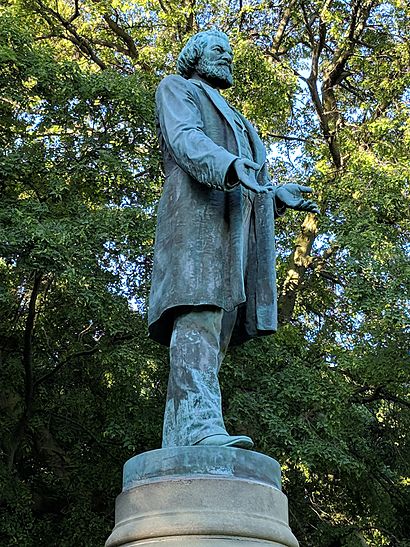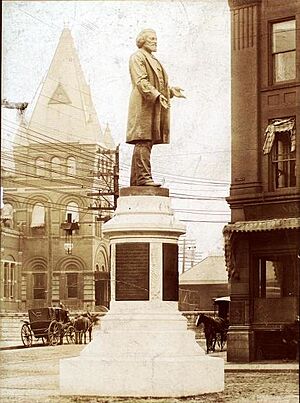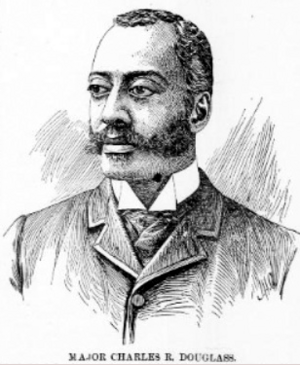Statue of Frederick Douglass (Rochester, New York) facts for kids
Quick facts for kids Statue of Frederick Douglass |
|
|---|---|
| Frederick Douglass Monument | |

The statue in 2018
|
|
| Artist | Sidney W. Edwards |
| Year | 1899 |
| Medium |
|
| Subject | Frederick Douglass |
| Location | Rochester, New York, U.S. |
| 43°07′59″N 77°36′29″W / 43.133°N 77.608°W | |
The Statue of Frederick Douglass is a famous sculpture in Rochester, New York. It was created by Sidney W. Edwards and put in place in 1899. An African-American activist named John W. Thompson asked for it to be made.
This statue was very special because it was the first one in the United States to honor a specific African-American person. It was first located near the Rochester train station. Later, in 1941, it was moved to Highland Bowl, a natural outdoor theater. In October 2019, the statue moved again. It became the main feature of a new area called Frederick Douglass Memorial Plaza. The base of the statue has special plaques with famous quotes from Douglass's speeches.
Contents
What the Statue Looks Like
The statue of Frederick Douglass stands tall in Memorial Plaza. This spot is close to where Douglass used to live. He is shown with a beard and mustache. He wears a long coat, a bow tie, and a vest with a watch chain.
One of his feet is forward, and his arms are out with his palms facing up. The statue is made of bronze and is about 8 feet (2.4 meters) tall. It sits on a round granite base. This base has four bronze plaques. The whole statue rests on a larger, eight-sided granite block.
Around the main statue, there are other sculptures shaped like pillars. These pillars represent Polaris, also known as the North Star, and other star groups. The North Star was very important to Douglass. His anti-slavery newspaper, published in Rochester, was even called The North Star. This name reminded people that enslaved people followed Polaris north to find freedom.
Important Words on the Statue
The monument has several messages carved into it. On the back of the base, you can see the name of the company that made the granite: "SMITH GRANITE CO. / WESTERLY, RI".
Another plaque on the back shares some of Douglass's powerful ideas:
- "THE BEST DEFENCE OF FREE / AMERICAN INSTITUTIONS IS / THE HEARTS OF THE AMERICAN / PEOPLE THEMSELVES."
- "ONE WITH GOD IS A MAJORITY"
- "I KNOW OF NO RIGHTS OF RACE / SUPERIOR TO THE RIGHTS OF / HUMANITY."
One side of the base has a quote from a speech Douglass gave in May 1857: "I KNOW OF NO SOIL BETTER / ADAPTED TO THE GROWTH OF / REFORM THAN AMERICAN SOIL / I KNOW OF NO COUNTRY. / WHERE THE CONDITIONS FOR / EFFECTING GREAT CHANGES / IN THE SETTLED ORDER OF / THINGS, FOR THE DEVELOPMENT / OF RIGHT IDEAS OF LIBERTY / AND HUMANITY ARE MORE / FAVORABLE THAN HERE IN / THESE UNITED STATES."
On the opposite side, there's another quote from a speech in August 1857: "MEN DO NOT LIVE BY BREAD/ALONE; SO WITH NATIONS, THEY / ARE NOT SAVED BY ART, BUT BY / HONESTY; NOT BY THE GILDED / SPLENDORS OF WEALTH BUT BY / THE HIDDEN TREASURE OF / MANLY VIRTUE; NOT BY THE / MULTITUDINOUS GRATIFICATION / OF THE FLESH, BUT BY / THE CELESTIAL GUIDANCE / OF THE SPIRIT."
How the Statue Came to Be
Making and Unveiling the Statue
In 1894, John W. Thompson started working to create a monument. He wanted to honor the African-American soldiers who died in the Civil War. Thompson was a waiter and a leader of a group called Eureka Lodge #36 of Free and Accepted Masons. This group mostly had Black members.
Thompson was inspired by another monument in Rochester that honored soldiers. However, that monument did not show any Black figures. So, his group formed a committee to create a monument for Black soldiers and sailors. At first, they didn't get much support.
They wrote a letter to Frederick Douglass, who was living in Maryland at the time. Douglass wrote back on December 3, 1894, saying he would be proud to see the monument built in Rochester. He said Rochester felt like home because he spent many important years there helping his people.
Newspapers in Rochester asked for money to build the monument on December 21. But some people thought the existing monument was enough for all war dead. On December 22, a meeting decided to build a tall pillar for the Black war dead, with a statue of Douglass on top.
Sadly, Douglass died unexpectedly on February 20, 1895. The very next morning, Thompson announced that the monument would now be built to honor Douglass himself. Once enough money was collected, sculptor Stanley Edwards began making the 8-foot bronze statue. He used Charles Remond Douglass, Frederick's son, as the model for the sculpture.
The location of the statue was a big discussion. The committee first wanted to put it in Plymouth Park, in the middle of Rochester's Black community. But local residents didn't want it there. Other city residents wanted a more central spot. Finally, they decided to put it near the New York Central train station.
The statue was supposed to be shown to the public on September 14, 1898. But just two days before, they found out it wasn't ready. Still, almost 3,000 people gathered on September 14 for a ceremony. The monument was officially given to the city.
Rochester's Mayor, George E. Warner, gave a speech. He said the city was proud to have welcomed Douglass. He also said it was fitting for the statue to be near a main entrance to the city. This way, thousands of visitors would see that Rochester was proud that its most famous citizen was not a white man.
Other important speakers at the event included Susan B. Anthony, who fought for women's rights and against slavery, and Ida B. Wells, a founder of the National Association for the Advancement of Colored People (NAACP). The statue was finally shown to the public on June 8, 1899. Ten thousand people were there. It was like a holiday in Rochester, with a parade that included the military. The Governor at the time, Theodore Roosevelt, also spoke at the unveiling.
Later History and Moves
In 1941, the city decided to move the statue. It was moved from a busy street corner to a quieter spot in Highland Park. This new spot overlooked a natural outdoor theater.
In 2019, the statue was moved again to Frederick Douglass Memorial Plaza. This made it the main feature of the plaza. A local pastor, Rev. Julius D. Jackson, Jr., had been asking for the statue to be moved to a more visible place for almost ten years.
During the move, a time capsule was found under the statue's base. It seemed to contain newspapers and books. However, the items were too damaged to be saved. The move was planned for Douglass's 200th birthday in 2018, but it was delayed. The city's project manager for the celebration said the new, more visible location was like the original spot. She explained that putting it at the train station originally sent a message to arriving visitors that Douglass was important. Now, at the entrance to the Rochester Lilac Festival, it shows visitors how important Frederick Douglass's legacy is.
Douglass Bicentennial Replicas
In 2018, many events and celebrations took place for Douglass's 200th birthday. One big project was to move the original statue and also create many life-sized copies of it. These copies were placed around the city as part of a "history trail."
The project leader said they wanted to bring the story of Frederick Douglass "off the pedestal and to the streets of Rochester where he walked." He added that they wanted people to think about what Douglass means today. The 13 new statues were made by sculptor Olivia Kim. She used epoxy and fiberglass, based on measurements of the original statue.
However, Kim changed the statues slightly to make Douglass look less stern. She said that in his older years, Douglass had a "genuine relaxation and happiness" in his face, which was rare earlier in his life. She explained that his life was full of struggle, but also about finding a way through. The hands of the new statues were made from a mold of Ken Morris Jr., a descendant of Douglass.
The statues were placed in important locations connected to Douglass's life:
- The Talman Building, where his newspapers The North Star and The Frederick Douglass Newspaper were published.
- The former site of the AME Zion Church, where The North Star was first published. This church was also a stop on the Underground Railroad.
- The former site of the Douglass Family farm.
- The building that was once the Central Presbyterian Church, where Douglass's funeral was held.
- The original location of the Douglass statue from 1899.
- The place where Douglass gave his famous "What to the Slave Is the Fourth of July?" speech.
- Douglass's first home.
- The site of the Seward School, which Douglass's children attended.
- Kelsey's Landing in Maplewood Park, a place where people escaping slavery would leave by boat.
- Mount Hope Cemetery, where Douglass and his family are buried.
- The Soldiers' and Sailors' Monument in Washington Square Park. This monument first gave the idea for the Douglass statue.
- The University of Rochester's Rush Rhees Library, which has information on Douglass's work in Rochester.
- SUNY Rochester Educational Opportunity Center, The College at Brockport, State University of New York display on Douglass's commitment to education.
Damage to the Replicas
Soon after they were put up, two college students were arrested for badly damaging a replica statue at the Seward School site. Their college suspended them because many people in the community were very upset.
In June 2020, the replica statue in Maplewood Park was pulled from its base. The statue was later found in a nearby gorge, damaged. Carvin Eison, who leads the project to honor Frederick Douglass's legacy in Rochester, said that another replica statue would replace it. He said, "I’ve always said if one goes down ten more go back up." The police started an investigation into the damage.








